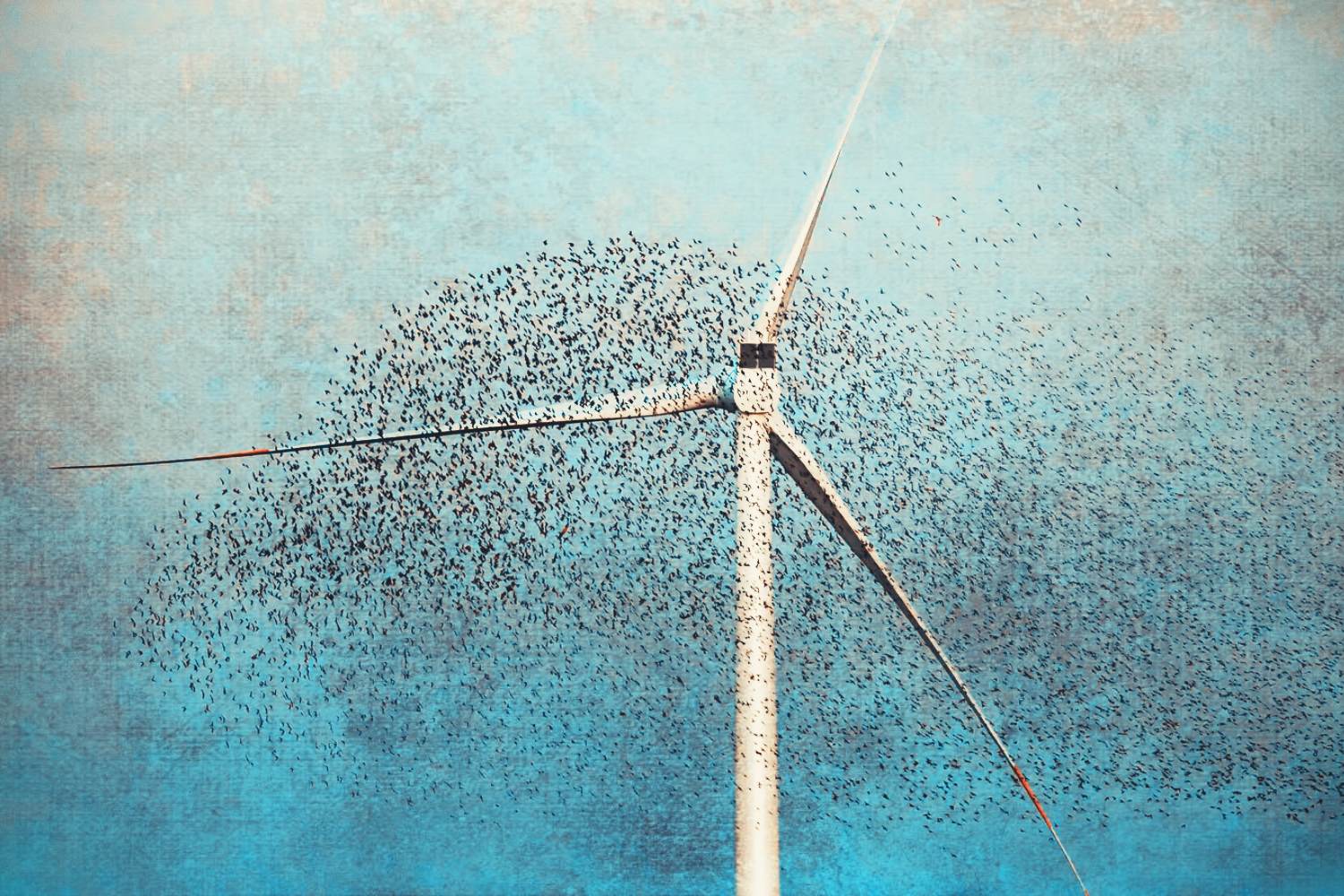The destruction of migratory birds by industrial wind turbines has earned them the well-deserved title “bird blenders.” But even more alarming is the far more widescale destruction of bat populations, many of them now endangered species.
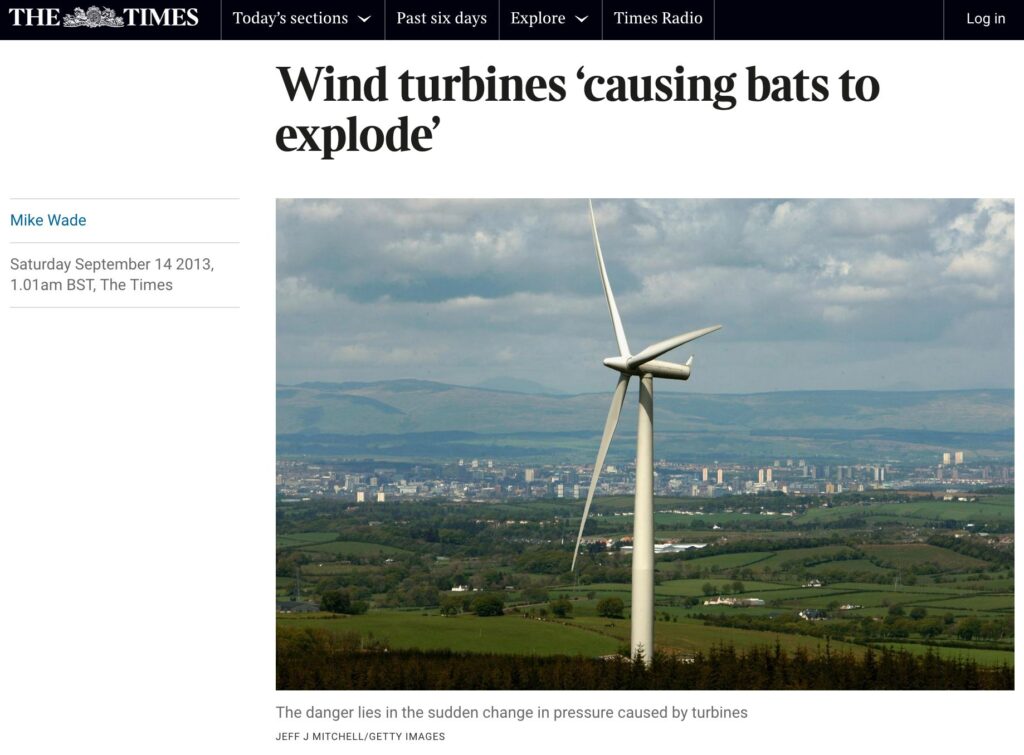
Studies in both Germany and North America have determined that hundreds of thousands if not millions of bats are being slaughtered now annually by wind turbines. There appear to be two causes of death, the first being blunt force trauma: the bats are hit by the turbine blades, suffering broken arms, wings, and skull bones. The second, believed to be the majority of fatalities, is through what is known as “barotrauma”: as a turbine blade spins, it forms pockets of low-pressure air trailing behind the blade. The sudden expansion of the air in nearby bats’ lungs causes them to rupture resulting in fatal hemorrhaging. Either is a brutal death.
Unlike birds, it appears that bats are actually drawn toward turbines, either mistaking their tall structure for trees or perhaps because insects and moths, the staple diet of most bats, are drawn to wind farms by the heat they generate.1
We don’t have a satisfying explanation for why we’re seeing such large numbers of bats. It seems they’re being attracted to turbines.
Paul Cryan, U.S. Geological Survey, August 26, 2008; Scientific American
Certain species are attracted to wind turbines. When we point thermal cameras up and watch bat activity in and around wind turbines, we see bats contacting the structures like the tower, the nacelle, chasing the blades, making swoops and patterns. It’s not just bats randomly passing through and happening to get hit by the wind turbine blades; they’re spending time and increasing their risk.
Dr. Cris Hein, Senior project lead in the National Renewable Energy Laboratory, November 18, 2022; Cosmos Magazine
With wind energy corporations building increasingly taller turbines, the crisis is only worsening.
As turbine height increases, bat deaths increase exponentially. What we found is a lot of internal hemorrhaging.
Erin Baerwald, Ecologist, University of Calgary; August 26, 2008; Scientific American
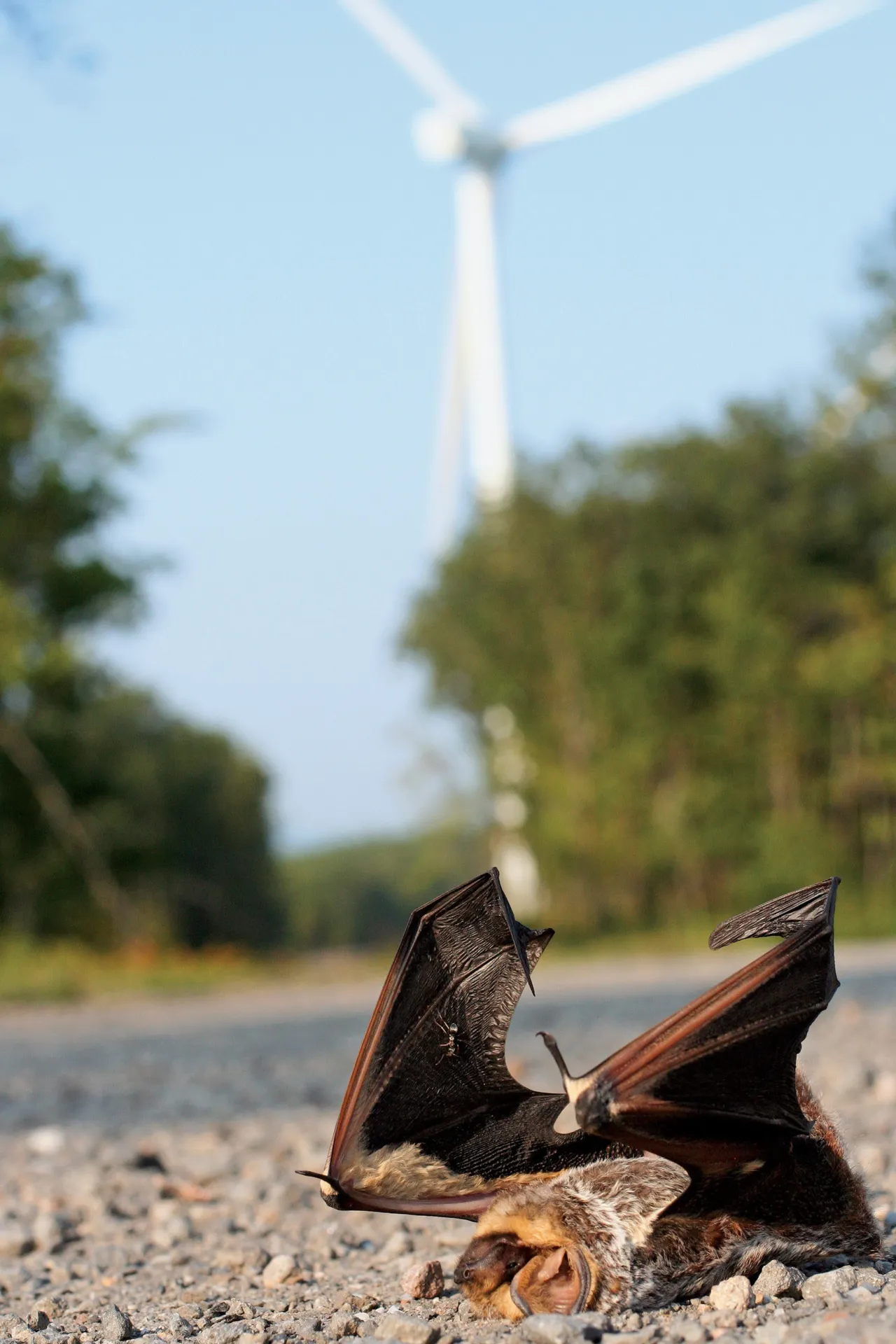
according to Texas-based Bat Conservation International.
Photo by Michael Schirmacher, Bat Conservation International
“When you start wiping out bat populations like this that are already in decline, the concern isn’t just the loss of endangered species but the impact this has on the entire ecosystem,” says Wind Concerns Editor-in-Chief, Mark Mallett.
Experts predict that four bat species will lose more than half of their populations due to collisions with wind turbines in the next 15 years if effective conservation actions are not taken soon.
“State of the Bats Expert Elicitation Summary”, 2023, batcon.org
Bats play an essential role in pest control, pollinating plants and dispersing seeds. Recent studies estimate that bats eat enough pests to save more than $1 billion per year in crop damage and pesticide costs in the United States corn industry alone. Across all agricultural production, consumption of insect pests by bats results in a savings of more than $3 billion per year.2 “They also keep moths and caterpillars at bay increasing crop yields,” says Professor Fiona Mathews of Exeter University who published a study on wind farm bat casualties.3 “So it’s something that affects us all.”4
Earlier this year, the Committee on the Status of Endangered Wildlife in Canada (COSEWIC) announced that the Hoary Bat, Eastern Red Bat and Silver-haired Bat have been assessed as Endangered in Canada. This listing now means that 5 of the 9 bat species that occur in Alberta have been formally assessed as Endangered.5
Moreover, “it is illegal to harm or kill any species of bats in Alberta,” which are protected under the Alberta Wildlife Act.6 Across North America, millions of cave-hibernating bats have died from the disease White-Nose Syndrome, caused by a fungus that grows in caves. This fungus was detected in Alberta in 2022. According to the Alberta government’s fact sheet updated in June 2023, “It is important to protect bats and their habitat to ensure they can recover from the disease.”6
It isn’t clear, then, how any future wind turbine projects can be approved without violating this provincial law — unless the province grants a wind energy corporation a permit to essentially continue the slaughter.
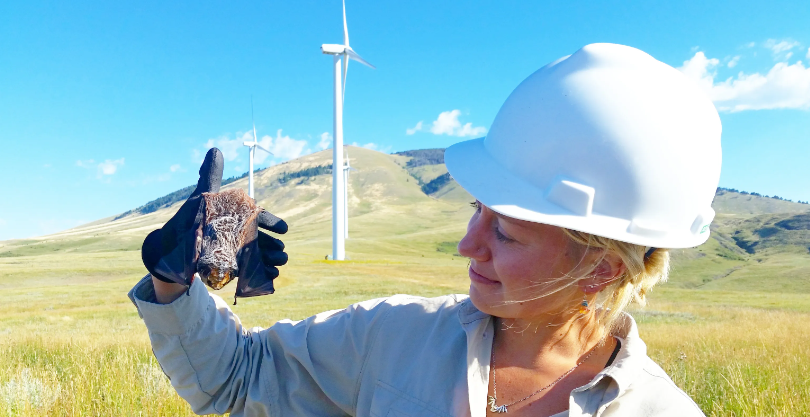
“So if I swing a bat and kill one of these species, I go to prison,” says Mallett. “If the wind energy corporations do it, several times a day, they get a free pass. When wind energy is unreliable to begin with, why are governments continuing to allow these environmentally destructive industrial wind plants to continue?”
In order to mitigate bat deaths, some wind companies are turning off their turbines at night or during migratory periods.
We need to remember bats have been around for at least 30 million years and during that time have been able to fly happily without the risk of colliding with a spinning object. If bats are actively attracted to turbines then it might not prove possible to predict this accurately in advance.
Professor Fiona Mathews, Exeter University, Nov 8, 2016, Express
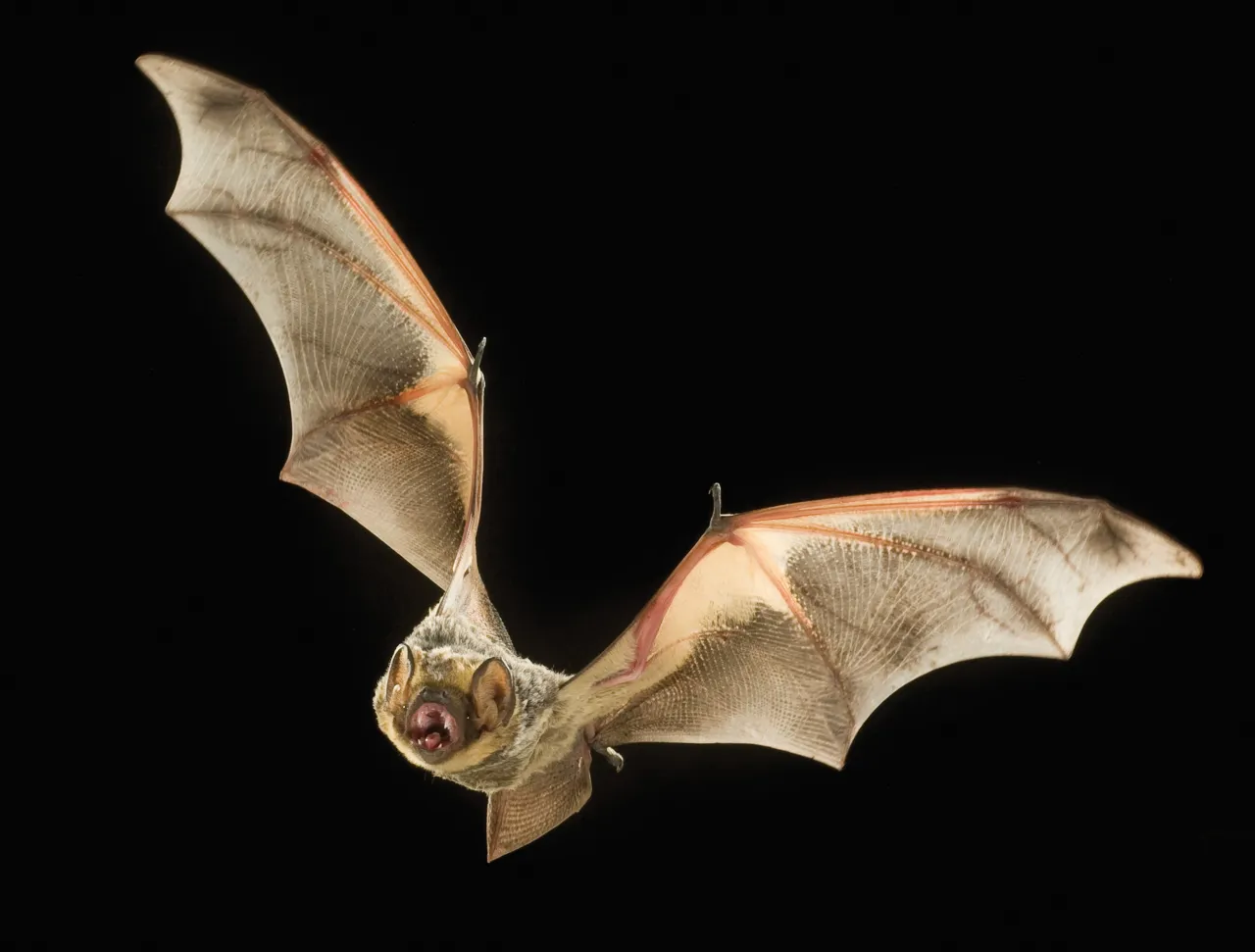
Photo: Michael Durham/Minden Pictures,
Bat Conservation International
“So how is this a solution for creating reliable energy?” asks Mallett. “This is the point that Premier Danielle Smith has been repeatedly asserting: the power grid needs constant and reliable energy. That’s neither wind nor solar at the best of times. And the solution is to make wind energy even less effective? This is nonsensical.”
Trudeau’s federal government is now demanding that provinces reach so-called “net-zero” emissions by 2035. However, Saskatchewan’s leader called the plan “impossible” while Premier Smith warned this would create energy insecurity and is “unconstitutional, irresponsible and utterly out of step with reality.”7
“So, from where we stand,” says Mallett, “we are strongly urging the Premier to simply put an end to wind energy expansion in this province and look for other clean reliable sources that aren’t so incredibly harmful, destructive, and divisive. There is absolutely nothing “green” about wind energy. Period.”
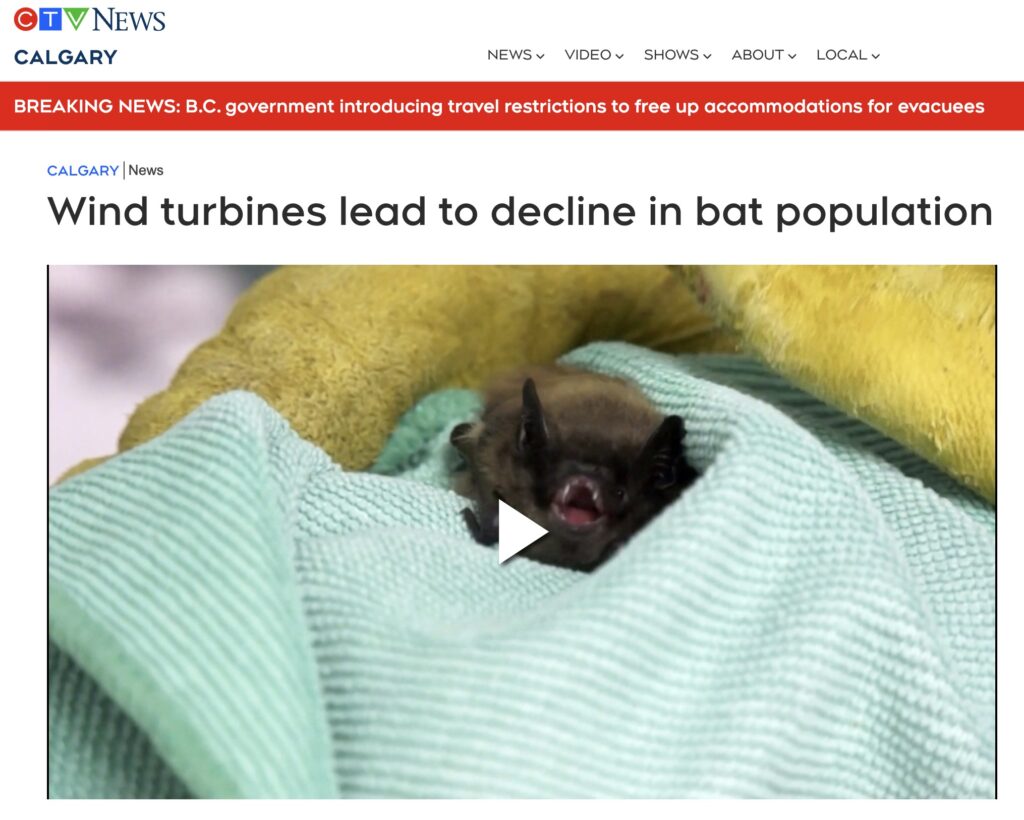
Wind turbine plants take up huge tracts of land; they require massive amounts of fossil fuel to manufacture, transport, and install; they have a short lifespan; they produce power unreliably; they are toxic and present serious problems in their decommissioning; they kill massive amounts of large migratory birds, bats, and now whales; they use up prime farmland; they destroy pristine landscapes; and they have been proven definitively to harm both human and animal health.
“And now, if we continue to destroy bats which are essential to our ecosystem,” says Mallett, “how exactly are we saving the planet?”
Watch: Oregon researcher warns some bat species may go extinct due to turbines:
“Bats and Wind Energy: A Crash Course in a Wicked Problem”:
- cf. thetimes.co.uk[↩]
- U.S. Fish and Wildlife Service, cf. fws.gov[↩]
- cf. “Ecological Impact Assessments Fail to Reduce Risk of Bat Casualties at Wind Farms”[↩]
- cf. Nov 8, 2016, Express[↩]
- albertabats.ca[↩]
- cf. “Bats in Alberta“[↩][↩]
- cf. Trudeau’s Reckless Green Dream[↩]
Wind Concerns is a collaboration of citizens of the Lakeland Alberta region against proposed wind turbine projects.

